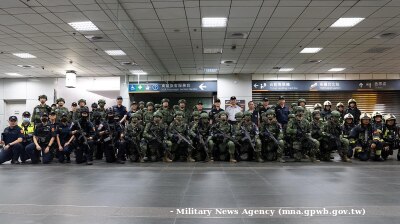Descended from the Mongols, the Hazara people are the most repressed ethnic minority in Afghanistan. Now, with the Taliban takeover, they fear for their lives. Many hope that the Mongolian government will help them escape to Mongolia.
The population of Afghanistan is composed of numerous ethnic groups, including Pashtun, Tajik, Hazara, Uzbek, Turkmen, Baluch, and others. Among them, the Hazara are considered the most persecuted, in spite of being one of the largest minorities, comprising around 4mn of the country’s population of 38mn. The Hazara follow the Shi'ite sect of Islam, while the majority of Afghanis follow Sunni. And this is one of the largest reasons for the repression.

Hazaras in Behsud, central Afghanistan (Image: Nasim Fekrat, CC-BY-SA 2.0).
Kabul, a city of 7mn, is home to about 1mn Hazaras, with perhaps half a million in Iran. The historical language of the Hazara is Hazaragi but most of those living in major cities speak standard literary Dari (also called Afghan Persian). Most of the educated can also speak English. The rest of the population of Kabul largely speaks Pashtu.
Hazaras are concentrated in the western part of the Afghan capital, living in Hazara neighborhoods. Before the Taliban took power as the US and allied forces departed the country, many Hazara children attended government schools, while others attended private Hazara schools. In the city, they tend to dress like everyone else, while in the countryside, traditional clothing is more common.
Attacks on Hazara people date back to Abdur Rahman Khan (1880–1901), when hundreds of thousands of Hazaras were killed or enslaved. These attacks drove nearly half the population of Hazarajat, the mountainous Hazara homeland in Afghanistan, into neighbouring Balochistan in British India, and Khorasan in Iran.
Under the first Taliban regime, bombings and other attacks on Hazara occurred nearly every day. After the fall of the Taliban, and the beginning of the American era, life improved for the Hazara. In a Skype interview from Kabul, 18-year-old Hazara, Ghafoor, explained: “Things were better with the Americans. We could study, go to university, get a good position, a good salary.”
Horrific attacks
More recently, hundreds of Hazara have been killed in terrorist attacks in Kabul, with either the Taliban, Islamic State or Al-Qaeda taking responsibility. These attacks have been focused on Shia shrines, Hazara protests and schools. A Hazara maternity hospital was attacked by gunmen, which resulted in 24 dead. One of the more horrific attacks came when a suicide bomber detonated in the street outside of the Syed Al-Shahada School, in a largely Shia Hazara neighbourhood, in western Kabul.

There has been international news coverage of the wave of bomb and other attacks lately suffered by the Hazara, but their plight is largely forgotten amid the repression and horror setting in in Afghanistan overall.
Ghafoor recounted that terrible day. “It was about 4pm and I was in my course. The time I was coming home I saw the girls lying in the street covered with blood and people carrying the girls to the hospital… and the worst situation, families could not find their daughters.” Ghafoor explained that, normally, boys went to school in the morning and girls in the afternoon. Consequently, most of the roughly 100 victims were Hazara girls.
Saliha, a young Hazara woman aged 20, living in Kabul, said via Skype: “Every day about three to four people are killed.” She went on to say: “With the Americans everything was better. They brought free government, and girls and women could go to school and work. But with the Taliban, we cannot work, but we have to pay rent. If people have no salary, how can they find money to pay rent or buy food?”
Saliha’s family situation is extremely difficult, but all too common in Afghanistan. Her family has six children. Their father is ill, so the children must work to support the family. The only male child is six years-old and clearly cannot work. Under the Taliban, the girls will be barred from working or studying. “Even if the Taliban wanted to reopen the universities, there are no teachers, because they all left the country,” Saliha added.
Saliha was studying at university while supporting her family by working as a teacher. Now, the Taliban has put an end to her dreams of an education and career. “When the girls were on their way to work, the Taliban stopped them and said 'Go home'!” Saliha said. She added that the women have been protesting in the streets, demanding education and employment rights, but the Taliban had used violence to disperse them, even firing their weapons in the air. “But every day, the women go back.” said Saliha. “They are very brave.”
Ghafoor’s family are also suffering, economically. His father is a shopkeeper and although the shop is allowed to remain open, there are no customers. Food prices are rising and people are afraid to spend their money.
Concerning Taliban repression of the Hazara, Ghafoor said: “With the Americans, Hazara could work in the government. Now, the Taliban are killing anyone who worked for the old government. And there will be no Hazara in the new government.”
Saliha had her own theories on why the Taliban have targeted the Hazara. “The Taliban hates Hazaras because we are intelligent and work hard and have good jobs and good positions. But they don’t want to see that. They are afraid Hazaras will have too much power.”
Ancient relationship
Ghafoor and many other Hazara hope that the Mongolian government will grant them permission to live in Mongolia, because of the ancient relationship between the two races.

Hazarajat, or Hazaristan, is a mountainous region in the central highlands of Afghanistan (Image: Wiki entry, Hazara people series).
A historian in Mongolia, who preferred not to give their name, explained the connection, recounting: “Khazar Mongolians [as they are known in Mongolia] are people who were deployed to the East by Chinggis Khan.”
Erkhembayar, a professor of Mongolian history at Mongolia’s Ider University, elaborated: “During the reign of Hulagu Khan, the grandson of Genghis Khan and brother of Kublai Khan, around the 13th century, it is believed that there were three lines of Mongolian ancestry: Tsar, Khazar (or Hazara), and Mongol.”
One reason why the Hazara face discrimination is that they look different from the Turkic peoples of Central Asia. Said the historian: “In general, their facial structure is also still the same as Mongolian.”
Some people feel that the connection between modern Mongolians and Hazara is too distant to claim kinship, but the academic has no doubts. “Khazars, I view them as a part of Mongolia. One of our peoples.” He reiterated: “I firmly believe Khazars are a part of Mongolia.”
As for Mongolia potentially absorbing the Hazara, he said: “Well, personally, since our numbers are not that high, it is possible to invite those people over. But the hundreds of years of disconnect has made it so that their culture and manners are different. It would require time to reassimilate. Because their culture and traditions are different, there will be a lot of clashes and cultural shock, from our side.”
As for the political implications of accepting the Hazara, he seemed less optimistic. “There are also issues of national security. I think politicians believe there is a possibility that the Taliban would target us.”
The historian confirmed that there is a precedent for Mongolia welcoming Hazara. During the time of Tsakhiagiin Elbegdorj, who served as president of Mongolia from 2009 to 2017, “we brought in two or three Khazar children. That’s why I think it would be fine to bring them here. Personally, I’d like to bring them over and if so, maybe to around the Gobi areas which are similar to the environmental characteristics of Afghanistan.”
Erkhembayar took a more nuanced approach. “The Khazar are viewed as the residuals of the Mongolic ruling period. There are a lot of legends/stories about how we will go and bring our people back… But they’ve been dissolved into a different culture. They lost their religion and their language.”
As for accepting Hazara into Mongolia, Erkhembayar said: “Some Khazar college students transfer to our universities with scholarships. Some Mongolians are also opening charities for them. And public opinion is open towards them. In my opinion, there is a possibility to receive those people in limited numbers. Why not? Immigrants are accepted all around the world. Our country is also responsible and actively involved in peacekeeping activities, so why not?”

Hazara girls in traditional red hijabs in Ghazni (Image: US Air Force, public domain).
“Tell the world to please invite us,” implored Seliha.
Some Afghans are so desperate to leave their country, they would do almost anything. Ghafoor sent screen shots of a scam his family had almost fallen for. Someone claiming to be a visa agent in Hawaii said that if his family sent $1,000, he could get visas for all seven of them to emigrate to the United States.
Ghafoor said that he wanted to send this message: “Mongolian government, please give us visa to go to Mongolia. Hazaras are Mongolian people. The population of Mongolia is so small. So, they need good, talented people to work in their country. So, I think Hazara can be good for Mongolia.”
He concluded by appealing: “Tell the Mongolian government about the situation, about the killing, and the Taliban and joblessness and that we cannot study or live here now.”
The author, Dr. Antonio Graceffo PhD China-MBA, worked as an economics researcher and university professor in China, but is now living in Ulaanbaatar, writing about the Mongolian and Chinese economies. He holds a PhD from Shanghai University of Sport Wushu Department where he wrote his dissertation “A Cross Cultural Comparison of Chinese and Western Wrestling” in Chinese. He is the author of 11 books, including A Deeper Look at the Chinese Economy, The Wrestler’s Dissertation, and Warrior Odyssey. He completed post-doctoral studies in economics at Shanghai University, specializing in US-China Trade, China’s Belt and Road Initiative, and Trump-China economics. His China economic reports are featured regularly in The Foreign Policy Journal and published in Chinese at The Shanghai Institute of American Studies, a Chinese government think tank.
Features

INTERVIEW: Can Albania’s tourism miracle last?
As social media brings in the crowds, the head of the Albanian Tour Operators Association tells bne IntelliNews Albania should turn away from mass-market tourism and focus on higher-value offerings.

COMMENT: Taiwan’s equality paradox - when “progressive” doesn’t mean equal
Taiwan’s insistence that women should have access to every privilege of citizenship - from political office to professional advancement - but not its responsibilities, undermines the moral foundation of its democracy.

Russian e-commerce giant Wildberries goes on a mysterious M&A spree
Russian e-commerce giant goes on M&A spree Almost a year after the controversial merger with a leading outdoor advertising firm, Russia’s leading e-commerce site Wildberries is indulging in a fresh bout of eyebrow raising deals.

US expands oil sanctions on Russia
US President Donald Trump imposed his first sanctions on Russia’s two largest oil companies on October 22, the state-owned Rosneft and the privately-owned Lukoil in the latest flip flop by the US president.




